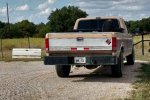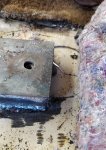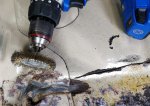I just set up my new Miller Multimatic 255 today.
The bottle I bought is 75/25. I'm confused by terms.
Is pulsed MIG a spray weld? How about MIG?
A well-known local shop ... recommended 75/25 for pulsed MIG so that's what I bought.
I have room for a second bottle though if I need it. There is actually room for three bottles on that big cart.
Any help is welcome.
Congratulations on your new welding machine!
I remember your other thread on weldingsite.com where you were exploring what MIG/MAG machine to get. Back on that thread, I suggested "to be sure and budget for two bottles of gas", and that suggestion still stands. Only now that you say that your cart can hold thee bottles, and in that other thread you said you plan on doing stainless, you might consider three bottles, where the third bottle is a trimix with the bulk gas being helium for the stainless.
Yes, pulsed MIG is a spray process, where the heat build up is reduced by the welding machine's control of the wave form.
The weld deposit is "sprayed" in a pulse process... where the wire is pinched into many tiny droplets in mid air to bring heat and metal to the puddle.
That aspect of pulse is just like spray, and more importantly to your immediate question, quite UNLIKE short circuit MIG/MAG, where the wire extends all the way to the puddle and short circuits, and the short circuit is what consumes the wire, delivering heat and metal to the puddle.
How pulsed spray differs from "regular" spray is in the wave form. Machines capable of "pulsing" can modulate peak and background currents, and the ramping between them, to cause the wire to get hot enough to separate into tiny droplets mid-air without short circuiting into the puddle, but can then dial the heat back (hundreds of times per second, in pulses) to reduce the overall accumulation of heat during the pass.
There is no question that 75/25 is NOT the appropriate gas for spray, nor for pulsed spray. Not sure why the local shop made that recommendation, unless you described your bullnose floorboard project, where they might have recommended sticking with short circuit MIG and spot welding it ...or what I call "dot" welding, since you won't be using resistance tongs, but rather a single sided approach with a MIG gun.
It may be kind of a challenge to pulse spray a low heat input, wetted in, "seam sealer" like bead on 16 guage rusty sheet metal when trying the spray process for the very first time. The original sheet metal will start disappearing in front of your very eyes, as the canals of porus corrosion hidden in the core of the sheet make it thinner in net cross section than the distance between it's bottom and top surface would otherwise suggest. Fixing that floorboard with pulsed mig might take a fair amount of practice to get right. Even if you get your skills and settings dialed in to make a perfectly contiguous seam, what happens when that foot long weld cools? You might turn your bullnose floorboard into a taco (warped from crystals in the molten metal reorganizing themselves neatly as they cool). As I understand it, die hard Ford truck owners don't do Tacos.
A quicker solution might be to run a backing plate under the crack, and dot weld, in an alternating pattern skipping back and forth to spread the heat around and allow cooling time, as well as to manage the pull of distortion as the dot welds cool. Prep the backing plate, the underside of the floor board, and the top side of the floor board, by stripping all paint, corrosion, scale, and contaminants by abrasive/mechanical means down to bright shiny metal. The backing plate can be pre bent to follow the contours of the Ford OEM floor board along the seam that you are repairing. Future corrosion between the sandwich surfaces of the backing plate to the underside of the floorboard can be mitigated by precoating with weld thru primer. SEM makes CopperWeld for this purpose.
The term "MIG" is a misnomer that has evolved into a short hand description for all the different weld processes we discussed above (short circuit, spray, pulsed spray) that can be accomplished by a wire feeder, and a few more, like globular transfer, surface tension transfer, and other proprietary named transfers that are beyond the scope of your question. The reason MIG is a misnomer is that it stands for Metal INERT Gas. So from strictly a liturgical perspective, PULSED SPRAY is more accurately called MIG than short circuit transfer, which uses more active gas (C02). This is why in Europe, where you describe spending a decade, the term MAG is often used to describe short circuit, for Metal ACTIVE Gas. And this explains why the industry evolved to using the term GMAW instead of MIG or MAG, where GMAW simply stands for Gas Metal Arc Welding, no matter what kind of gas, be it inert, or active, or any mixture in between.
Get you a bottle of 90/10 (C10), or 92/8 (C8), or, if the previous two options are not available, some 90/7.5/2.5 (give or take a point or two up down on either of the three components), which would be Argon / CO2 / O2. The O2 will add more heat, and with a machine as robust as you have, you probably don't need to go that route. I just mention it because sometimes we are the victims of whatever the local gas supplier has in stock. I have a proportional gas mixer, but that's getting into the weeds, and since it's always a good idea to have a second bottle on hand anyway, you might as well fill up that big empty cart with a second bottle of C10 or C8 for you when you want to spray or pulse spray, and keep the C25 for when you want to short circuit.







